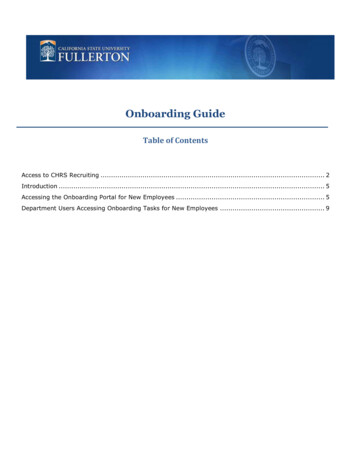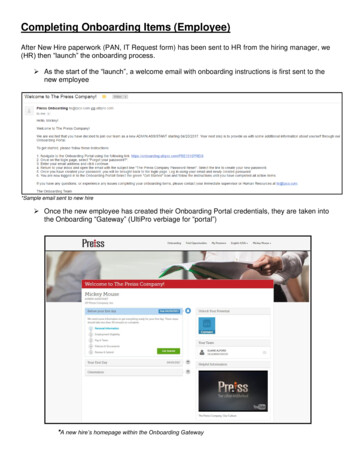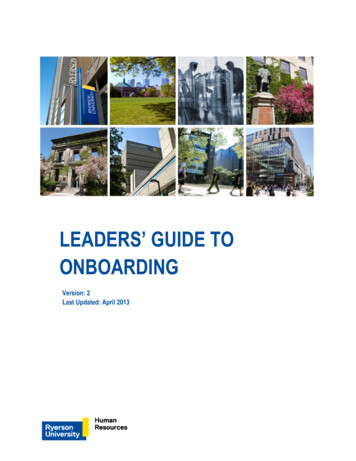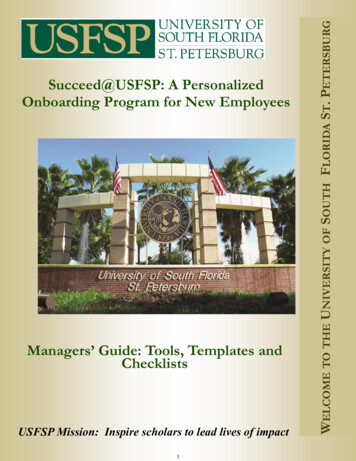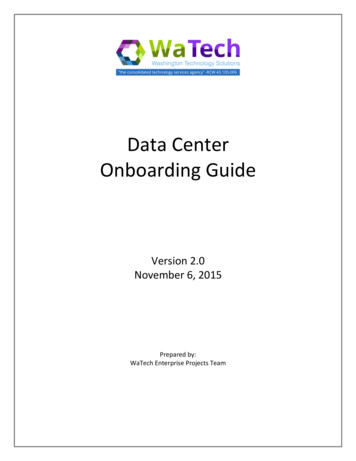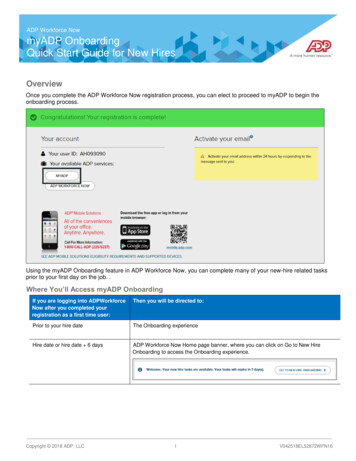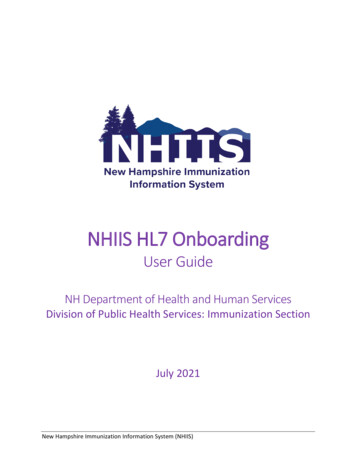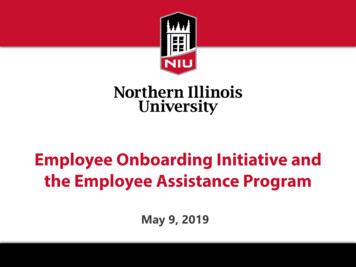
Transcription
MBA ThesisOnboarding during Covid-19Effects on newly graduated engineers in SwedenMattias Dalstål Gershagen & Martin KvistSupervisorJonas MånssonKarlskrona, SwedenSeptember 2021www.bth.se/mbaDEPARTMENT OF INDUSTRIAL ECONOMICS
This thesis is submitted to the Department of Industrial Economics at Blekinge Institute ofTechnology in partial fulfilment of the requirements for the Degree of Master of Science in IndustrialEconomics and Management. The thesis is awarded 15 ECTS credits.The author(s) declare(s) that they have completed the thesis work independently. All externalsources are cited and listed under the References section. The thesis work has not been submitted inthe same or similar form to any other institution(s) as part of another examination or degree.Author information:Mattias Dalstål Gershagenmattias.dalstal@gmail.comMartin Kvistmartin.kvist78@gmail.comDepartment of Industrial EconomicsBlekinge Institute of TechnologySE-371 79 Karlskrona, SwedenWebsite: www.bth.seTelephone: 46 455 38 50 00Fax: 46 455 38 50 57
AbstractBackground: The global pandemic caused by the virus Covid-19 provided an exogenic chock to theworld’s businesses. Governments all over the globe issued various restrictions or requests for allinhabitants that can, to work from home. Due to this, many companies ordered their employees towork from home. Working from home and working virtually became the new normal for many,including their newly hired staff.Objectives: The study examines how the adaptations Swedish engineering companies made to copewith Covid-19 have affected their onboarding processes and the time to productivity.Methodology: Through a survey sent to 327 Swedish engineering businesses asking questions abouthow their onboarding process and the results thereof has changed due to the adaptations to thepandemic. On top of this, ten interviews with company representatives from the invitation list wasperformed to try and deepen the understanding of the survey results and to find out if there are anyspecific onboarding processes or activities that are of extra significance during and after thepandemic to ensure an effective onboarding process.Results: In total, 74 responses for the survey were collected. The study finds that working from homeand the use of digital tools and ways of working for onboarding have increased significantly duringthe pandemic and is expected to remain at an increased level after the pandemic as well. Workingfrom home is expected to be lower than during the pandemic, but higher than before. The change tovirtual onboarding appears to have had little or no prolonging effect on time to productivity.Due to the fact that the evidence points towards time to productivity not being very affected by thechanges made by the companies during the Covid-19 pandemic, it is hard to know if the themes andactions identified in the interviews as being the most important for an effective onboarding actuallyhave an effect on time to productivity. The most common activities that the interviewees identifiedas important was mentoring time, structure, information transfer methods and follow ups.Conclusions: The Covid-19 provided an exogen chock to the Swedish engineering businesses thatcaused them to change their way of working and way of onboarding. Days working from homeincreased, and so did the use of digital tools and ways of working for onboarding. The resultsregarding which onboarding activities that affected time to productivity, our results are inconclusive.Recommendations for future research: Several of the interviewed mentions that a part of their staffseems to suffer significantly more than the general staff from working from home and being isolatedsocially. Further studies into this area could focus on why this group suffers so much more, and howto mitigate this issue. Further studies could also look further into which mechanisms or activities thathas the most effect on time to productivity. Our findings were not conclusive on this point.Keywords: Covid-19, onboarding, working from home, time to productivityi
AcknowledgementsWe want to thank our mentor Jonas Månsson for all his help achieving this thesis.We also want to thank our friends, families, and colleagues for their support.A special thank you to all the participants in our study, your contributions have been invaluable.Karlskrona, September 2021Mattias Dalstål Gershagen & Martin Kvistii
Table of contents1. Introduction 11.1.Problem discussion 11.2.Problem formulation and purpose 21.3.Delimitations 31.4.Thesis structure 42. Literature review & theoretical framework 52.1.What is onboarding 52.2.Covid-19 context 72.3.Working from home 72.4.Hiring/firing cost 92.5.Learning Curve and Time to productivity 92.6.Hypotheses 113. Methodology 133.1.Population and sample sizes 133.2.Quantitative Survey 143.3.3.2.1.Execution of the quantitative survey 143.2.2.Data Analysis Methods 153.2.3.Reliability of the instrument 15Qualitative Interviews 164. Data 184.1.Company size 184.2.Type of city 184.3.Type of Industry 194.4.Validity and reliability of the survey 204.5.Qualitative interviews 205. Results 215.1.Company size 215.2.Type of city 215.3.Most important activities of onboarding 21iii
5.4.Working from home 225.5.Time to productivity 255.6.Use of digital tools and ways of working 275.7.Other aspects of onboarding 305.8.Analysis 316. Conclusions 347. Bibliography 368. Appendix I: Interview data 409. Appendix II: Non-response analysis 50iv
List of TablesTable 1: The Four C's (Bauer, 2010) 6Table 2: Levels of onboarding (Bauer, 2010) 7Table 3: Recommendations for Remote Onboarding (Rodeghero et al (2020)) 8Table 4: Recommendations for Remote Onboarding (Holmberg & Larsson (2020)) 8Table 5: Survey participants per time period 18Table 6: Company sizes (European Commission, 2003) 18Table 7: City distribution 19Table 8: Industry category 20Table 9: Wilcoxon Signed Rank Test - work at home 23Table 10: Regression model coefficients - Work from home Covid-19 (3-5 days/week) 24Table 11: Wilcoxon Signed Rank Test - time to productivity (During – Post) 26Table 12: Wilcoxon Signed Rank Test - Use of digital tools and ways of working 29Table 13: Participants in interviews 40Table 14: Working from home 40Table 15: Recruitment 41Table 16: Onboarding Pre Covid-19 41Table 17: Onboarding during Covid-19 42Table 18: Onboarding post Covid-19 42Table 19: Time to productivity - Definition and way of measuring 43Table 20: The Four C’s - Compliance 44Table 21: The Four C’s - Compliance 45Table 22: The Four C’s - Culture 46Table 23: The Four C’s - Connection 47Table 24: Most important activities in the onboarding process 48Table 25: Other aspects 49Table 26: Survey invitations & answers 50v
List of FiguresFigure 1: Key drivers for onboarding 6Figure 2: Learning curve example (authors original) 9Figure 3: Impact of Onboarding process on an employee's value for the organization (BinderConsulting 2019) 10Figure 4: Simplified Model on Time to productivity 11Figure 5: Working from home 23Figure 6: Time to productivity (pre Covid-19) 25Figure 7: Time to productivity development 26Figure 8: Use of digital tools and ways of working (pre Covid-19) 28Figure 9: Use of digital tools and ways of working development 29vi
1.IntroductionJust as 2020 started, the world was forced into a digital transformation affecting large parts of thepopulation due to the global pandemic known as Covid-19 (World Health Organization, 2020).Working from home has become a new normal for many office workers around the globe. Most ofthese were already employed and simply continued their work from home. But what about thosewho had to begin their job career with working from home without an introduction to a physicalworkplace? How has the transformed way of working affected the newly graduated and theirlearning curve trajectory? What insights on onboarding newly graduates can be discerned by theindustry in the post Covid-19 era? In the following chapters we ask these questions to managers andHR-personnel in the Swedish engineering field through surveys and interviews to see how thepandemic has affected the onboarding process.1.1. Problem discussionThe global pandemic has changed the conditions of the workplace introduction, or onboarding, fornew employees in different ways. Many workplaces have at least temporarily transformed digitallyinto a work from home setup. The office has been replaced by the home office, physical meetingswith virtual ones and the coffee machine area has maybe not been replaced at all. Onboarding andthe processes for introducing new staff into the teams have been changed and adapted to thesituation as the companies and organizations need to grow or replace leaving/retiring employees. Asuccessful onboarding will be crucial both for the business as well as for the onboarded. Both partiesspend a significant amount of time and resources, and both want to get a return on the investment.The employers want to get a net contribution as quickly as possible. They also want to reach thepotential of the employee and get the employee engaged fast, while still having high retention. Therecruited want their career development, work-life balance, and compensation for the effort.There are a substantial number of studies regarding onboarding, but most are concerning the preCovid-19 situation where work-place introduction could be performed in an office and meetingcolleagues to collaborate with. One of the most significant writings on the subject of onboarding isOnboarding New Employees: Maximizing Success by Bauer (2010). In the report Bauer presents aframework for Onboarding that has set the standard for onboarding programs around the globe, butit is focused on onboarding during the “normal”, non-pandemic situation.Few studies are available about the virtual domain of onboarding. There are even less studies thatspecifically focus on the onboarding of the newly graduated: Those who are early in theirprofessional job career, many entering their first job position now in a completely virtualenvironment.Rodeghero et al (2020) performed a case study of the onboarding of software developers atMicrosoft. Through a survey asking 267 newly hired developers, that were onboarded during theCovid-19 pandemic, they found that communication was hampered by the work from home regime.They also found that the onboarded struggled to ask for help, build connections with their team andbond with teammates.1
Holmberg & Larsson (2020) also produced a case study of onboarding during the pandemic. Theyinterviewed six newly onboarded personnel at a Swedish IT department at a Swedish governmentalorganization. From the semi-structured interviews, they conclude that most issues with remoteonboarding are related to establishing the wanted work culture and the connection with theorganization and their new colleagues.The practice of “Shadowing”, following a more senior colleague, and thereby get to learn theworkplace basics, the unwritten code of conducts, company culture, social interplay will be different.These skills are vital for success, but impossible to learn in any education, and therefore need to bediscovered and assimilated. The use of technology to make information available to the new hirescould be positive, but Bauer (2010) suggests that employees taking part in computer-basedorientation gains less understanding of the job compared to hires that receive the same informationface-to-face.In this study we will focus on how the Swedish engineering companies have adapted to the newsituation. How they onboard when limited physical contact is possible, and if they expect these newtools they develop to remain after the pandemic is over. We expect our contribution to be a widerexamination of the Swedish Covid-19 response regarding onboarding compared to previous studieson the subject, and to give some new insights into what adjustments that has proven to reduce thetime to productivity in a remote work setting. We also hope to gain insight into how beginning acareer in a completely remote setting has affected the performance of the onboarding of newlygraduated engineers that are taking their first steps of their career in this pandemic setting.1.2. Problem formulation and purposeThe study is divided into two main parts. The present situation, and an outlook on the post pandemicera.The study investigates how Swedish engineering companies have adapted their onboarding processof newly graduated engineers to the conditions of the Covid-19 pandemic. How the virtualonboarding methods and tools for onboarding have been adapted, with the aim of finding the bestpractices and potential pitfalls. This may contribute to the area of knowledge and hopefully increasethe chances of a successful onboarding of the latest generation of higher educates.As mentioned during the problem discussion above, the subject of onboarding has been extensivelyresearched for over 20 years, but this new situation with the Covid-19 pandemic created anunprecedented opportunity to see how remote working during a pandemic will affect theonboarding process. Rodeghero et al (2020) have done this, but only focused on a single US softwarecompany. The same case is true for Holmberg & Larsson (2020). Both also put most of the emphasison the experience of the onboarded. With this study we want to broaden the view to include a widerselection of Swedish engineering companies. We will also change the focus to the companiesthemselves, the adaptations they have made to adjust to the pandemic and how they evaluate theresults of those efforts.2
To do this, it first must be investigated how the onboarding processes have changed during thepandemic and how it has affected the outcomes. For this, three research questions (RQ) have beenformulated:With RQ1 the aim is to set a foundation to understand how the companies examined in the studyresponded to the pandemic. Did they continue as before, or did they convert their onboardingprocess into a virtual one with the new hires receiving their onboarding from home?xRQ1: To what extent has Swedish engineering companies switched to virtual onboardingduring the Covid-19 pandemic?To attempt do judge if the (assumed) switch to a more virtual/digital onboarding process haveaffected the result, the concept “time to productivity” is used to measure if the onboarding time hasbeen affected by the change. This is reflected in RQ2.xRQ2: Has switching to virtual onboarding affected the time to productivity?To follow up to RQ2 and examine which parameters in the onboarding program of the companiesincluded in the study, RQ3 was formulated.xRQ3: What aspects of the onboarding process have most effect on time to productivity?The study will also investigate the foresights and perceptions of the engineering companies whendigitalization is not forced from a virus infection control perspective and how that will affectonboarding and introduction.xRQ4: What aspects of the onboarding process are expected to have most effect on time toproductivity when both the traditional and virtual methods are available in a post Covid-19environment?1.3. DelimitationsThe purpose of the study is to investigate the challenges of onboarding newly graduated engineers(Bachelor or Master’s degree) in their first job within their new profession, hired into businesses thatdue to Covid-19 have transformed onboarding from traditional workplace (mainly office) based tovirtual, where the new employee is not able to physically meet their coworkers or managers. It willfocus on those who have started their first employment after their (university) studies and wereonboarded for the first time during the pandemic. By limiting the study to the newly graduatedengineers, it can be focused to view the angle of “learning how to work”. This through virtualonboarding - not simply starting a new job and getting the introduction via different computer-basedtools. Below we list the criteria of the desired object(s) of study:xxxNewly graduated BSc or MSc in engineering or individuals who have received the entireeducation but started working without finishing the degree.Started their first employment within their new profession after finished studies, during theCovid-19 Pandemic.Employed within the engineering field in Sweden.3
1.4. Thesis structureChapter 2 will present the literature review of job introduction/onboarding, the Covid-19 pandemic,working from home and the relevant theoretical framework.Chapter 3 will present the selected research methodology and methods to collect the primary data.Chapter 4 will present empirical data.Chapter 5 will present the analysis.Chapter 6 will present the conclusion, recommendations and theoretical contributions. It will alsopropose future research recommendation.4
2.Literature review & theoretical frameworkIn this chapter, the theoretic work that form the foundation of this study is presented as well as thetheoretical framework used.The process of onboarding has been extensively researched for more than 30 years. Although thereis some consensus regarding some concepts, and widely different views on what is important andwhat has effect on the effectiveness of the onboarding. Also, how should the effect be measured?On top of the already complicated subject, there is the disruptive effect of the Corona virus Covid-19.Since the subject of onboarding in Covid-19 context is still young, little academic work has beenpublished regarding the effects on onboarding yet.2.1. What is onboardingBauer (2010, p. 1) defines onboarding as ”the process of helping new hires adjust to social andperformance aspects of their new jobs quickly and smoothly”.There are several definitions of onboarding in our reviewed literature. They differ somewhat fromeach other. Besides about mentioned quote from Bauer, there is also:--Onboarding is the “formal and informal practices, programs, and policies enacted or engagedin by an organization or its agents to facilitate newcomer adjustment” (Klein & Polin, 2012, p.268)“Onboarding is a process of introducing new hires into the new job, acquainting them withthe organization’s goals, values, rules, responsibilities, procedures, and socializing the newemployee into organizational culture.” (Chillakuri, 2020, p. 3)This variance also displays how varied the approach to onboarding is from the companies’ point ofview. It also varies in formality and can be either formal, informal or both (Bauer, Erdogan, Truxillo, &Tucker, 2007) (Klein & Polin, 2012) (Elset, 2018). There are also differences regarding whether or notauthors view socialization to be a part of the onboarding. Bauer and Erdrogan (2011) consider themsynonymous, Klein, Polin and Suttin, however, think they are two processes to be consideredseparate (Klein & Polin, 2012). Laurano (2013) suggest that onboarding and socialization are twomeans to an end, but different aspects of the process. The conclusion of Pavlina (2020, p. 8) is that“socialization process applies to anyone in the organization, whereas onboarding specifically appliesto new hires”.It is difficult to measure the specific effect of an onboarding program on a new hire (Laurano, 2013),but the overall consensus of previous research is that it has a positive effect on the long term successof new hires (Bauer, Erdogan, Truxillo, & Tucker, 2007). According to Aberdeen group (2006), aneffective onboarding process may improve retention rate by 52% and reduce time to productivity byas much as 60%. In 2012, Boston Consulting Group (2012) performed a global survey, investigatedand compared what HR practices that differ in capability between high performing companies andtheir low-performing competitors. The second most important HR practice was “onboarding of newhires and retention”. High capability in onboarding contributed to increased revenue growth and5
profit margins. The Aberdeen Group reports that in 2016, only about 32% of American companiesutilizes a formal boarding program for new hires (Aberdeen Group, 2016). The practice of onboardingis becoming more common, and workers are undergoing onboarding more in their careers (Bauer,Erdogan, Truxillo, & Tucker, 2007).Laurano (2013) and the Aberdeen Group (2016) examined onboarding strategies in 2013 andidentified key drivers for onboarding:Percentage of respondents, n 230Key drivers for onboarding80%70%60%68%67%50%40%51%49%Better employeeretentionBetter assimilation of newhires30%20%10%0%Getting new employeesproductive more quicklyBetter employeeengagementSource: Aberdeen Group, 2013Figure 1: Key drivers for onboardingStudies show that the quality of the onboarding will affect the above-mentioned drivers as well asothers (Bauer & Erdrogan, 2011) (Klein & Polin, 2012).Bauer (2010) states how onboarding may be looked at using four levels, the Four C’s. These arenamed Compliance, Clarification, Culture and Connection (Bauer T. N., 2010). These are alsodescribed as the building blocks of successful onboarding. Bauer claims that the degree to which anorganization is able to succeed within these areas determines the level of overall onboarding.Table 1: The Four C's (Bauer, 2010)Compliance“Basic legal and policy-related rules and regulations.”Clarification“Ensuring that employees understand their new jobs and all related expectations.”Culture”Providing employees with a sense of organizational norms—both formal andinformal.”Connection”Interpersonal relationships and information networks that newemployees must establish.”6
Bauer (2010) states that all organizations can be put into one of three categories depending on thesuccess rate of the four C’s: Passive, high potential, or proactive onboarding. Passive mostly coverscompliance and some clarification; high potential improves by adding some culture- and connectionbuilding. Proactive companies cover all areas extensively.Table 2: Levels of onboarding (Bauer, 2010)Onboardingstrategy levelPassiveHigh potentialProactiveCompliance Clarification CultureYesYesYesSomeYesYesConnectionLittle/none Little/noneSomeSomeYesYesRodeghero et al (2020) points out in their report, the importance of having an onboarding processthat can be adapted to the level of experience of the newly recruited, as there will likely be differentneeds from a newly graduated compared with an industry veteran.2.2. Covid-19 contextCovid-19 is a respiratory virus that created a worldwide pandemic (World Health Organization, 2020).To prevent further spread, many businesses in Sweden chose to close down offices and have theirwhite-collar staff work from home. Statistics Sweden (SCB) reported, in November 2020, that onethird of Swedish workers were working from home at least some day every week (StatistiskaCentralbyrån, 2020). During the period May 2020 to October 2020 the number of workers workingfrom home more than 50% of their work week varied between 13,7 and 21,8% with an average of16,6% (Statistiska Centralbyrån, 2020). Brynjolfsson et al (2020) estimates that nearly half of theAmerican workforce worked remotely at some time during the Covid-19 pandemic. Many businessesstill hired new employees during the period, and therefore had to perform their onboarding virtually(Andersson, 2020). During the autumn 2020, there was an increasing number of registrations of newcompanies in Sweden (Visma Sverige, 2020).2.3. Working from homeDue to the progression of globalization, teams of workers are commonly spread across the world andcommunicate virtually to coordinate their work (Ahuja & Carley, 1999). The reasons for companies toencourage remote work may be several: lower cost for offices, higher profits, improved customerservice, market access and better work-life balance for the employees (Cascio, 2000). This has alsoimpacted how new hires are onboarded (Elset, 2018) (Gruman & Saks, 2018). Ahuja and Galvin(2003) found that working from home (WFH) can limit the number of people workers interact with,which can decrease collaboration or limit perspective.Working from home requires a more active type of leadership. Cascio (2000) found that leadersneeded to change their mindset from time and activity orientation to a more project and resultfocused orientation. Cascio (2000) also found that communication skills, both formal and informal,needed to be improved to succeed in the virtual workplace.7
Diab-Bahman & Al-Enzi (2020) describes in their study that the majority of their participants havefound that working from home has contributed overall positively to their productivity and found iteasier to concentrate on their tasks compared to working in the office. Their participants expect theirorganizations to return to a hybrid work model after the pandemic, working partly from home andpartly from office. Diab-Bahman & Al-Enzi concludes that most work tasks can be performed in ahybrid environment today and with some changes all should be able to be done. They also concludethat the work-life balance has improved with more flexible work hours and less time spentcommuting to the office.As mentioned during the introduction, Rodeghero et al (2020) found that communication washampered by the work from home regime. They also found that the onboarded struggled to ask forhelp, build connections with their team and bond with teammates. They produce a list ofrecommendations to mitigate the issues caused by WFH (see Table 3).Table 3: Recommendations for Remote Onboarding (Rodeghero et al (2020))Recommendations for Remote Onboarding-Promote communication & asking for helpEncourage teams to turn cameras onSchedule 1:1 meetingsProvide information about the organizationEmphasize team buildingAssign an onboarding buddyAssign an onboarding technical mentorSupport multiple onboarding speedsAssign a simple first taskProvide up-to-date documentationAs also mentioned in the previous chapter, Holmberg & Larsson (2020) did a case study within aSwedish IT department on a governmental agency. They found that the rapid transfer to remotework brought some complications and may have hampered the results of the onboarding. They havealso produced some recommendations (see Table 4).Table 4: Recommendations for Remote Onboarding (Holmberg & Larsson (2020))Recommendations for Remote Onboarding-Increasing social interactions by creating opportunities for interaction withcolleagues outside of the smaller work group or teamEncourage the use of the web cameraEnsure that documentation is available and easy to find when neededMore focus on pre-boarding to let the new hire prepare themselves regarding theirrole and expectationsIncrease practical (remote) teaching. Let the new hire follow how a moreexperienced employee perform tasks through for example screen sharing8
Goodermote (2020) studied the remote o
specific onboarding processes or activities that are of extra significance during and after the pandemic to ensure an effective onboarding process. Results: In total, 74 responses for the survey were collected. The study finds that working from home and the use of digital tools and ways of working for onboarding have increased significantly during

